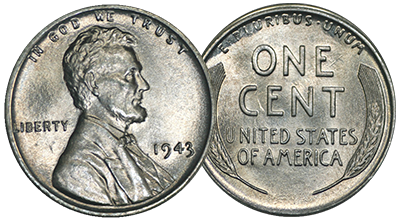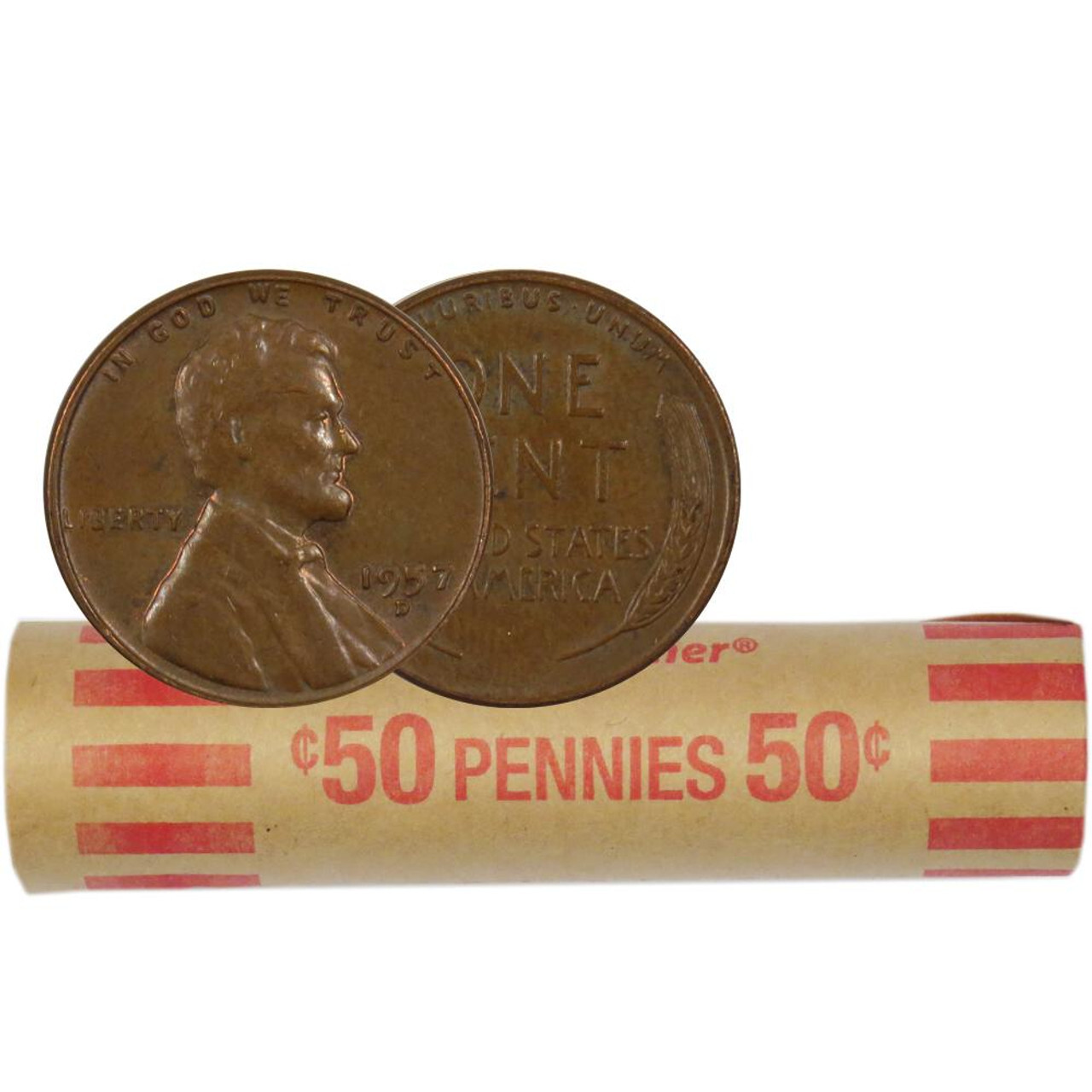Buy Lincoln Pennies Online (1909-1958)
In addition to the Lincoln penny’s mint year and edition, the coin’s condition is important when it comes to determining its value. Wheat pennies that have been well-preserved over the years can be valued significantly higher than similar coins that have wear and tear or damage.
The Lincoln Cent was minted from 1909-to present day, designed by Victor D. Berner. From 1909 to 1982 it was made of 95% copper and 5% zinc, and from 1982 to present it is made of 97.5% zinc and 2.5% copper. The original first type of Lincoln Cent is also called the Wheat Penny. People were so excited about the release of this coin that the treasury sold out of coins and the lines were extremely long. This was because the mint did not release any picture of the coin before release, leading many individuals to be curious about the design. The coin had President Lincoln on the obverse and the face value of the coin on the reverse. Other parts of the reverse have changed over the years.
Types of Lincoln Cents
The value of these coins comes from their low mintages and low survival rate in high grade. There are multiple coins in the series that have low mintages and are very hard to find in well-kept condition. Some of these coins are 1909-S VBD, 1914-D, 1931. These versions are very rare and cost thousands of dollars in the pristine condition. You can buy these in different forms, such as rolls of 50, albums and individuals.
Mint marks and the 1909 VDB Lincoln Cent
An “S” mintmark found under the date of a Lincoln Wheat Penny indicates that the penny was minted by the San Francisco Mint. Collectors desire these coins and they may trade for higher premiums than common date wheat cents.
A “D” under the date indicates that the penny was minted in Denver, while lack of a mintmark indicates that the penny was minted in Philadelphia.
Mint year 1909 also produced some wheat pennies with the designer’s initials, “VDB” for Victor D. Brenner. These initials may be found along the bottom rim of the coin just below the wheat stalks. Because fewer pennies were minted with the engraved initials, check your 1909 Lincoln Wheat Penny to see if it has the VDB engraving.
Lincoln Wheat Penny Value Is Rising
The Lincoln Wheat Penny value is constantly changing and may increase over the years. This can happen for numerous reasons such as new collectors buying these coins or established collectors adding to their collections. In addition, new varieties such as double-dies or over-dates may be discovered adding to the allure of Lincoln Wheat Pennies.
Where to buy Lincoln cents
For all those who would love to get their hands on Lincoln Cents and Wheat Pennies you can get yours at Bullion Shark. View one of the largest inventories of Wheat Pennies and Lincoln Cents here at Bullion Shark.
How does the transition in composition from copper to zinc in 1982 affect the value and collectibility of Lincoln Cents?
The transition in composition from predominantly copper (95% copper, 5% zinc) to predominantly zinc (97.5% zinc, 2.5% copper) in 1982 significantly impacts the value and collectibility of Lincoln Cents for several reasons. Firstly, the copper-based cents minted before 1982 inherently have a higher base metal value due to the rising price of copper, making them more valuable to collectors who consider the metal value. Secondly, the change in composition marks a distinct point in the series' history, creating a natural division for collectors who may specialize in either the earlier copper series or the later zinc series. Additionally, the copper coins tend to age and patina differently than the zinc coins, which can affect aesthetic preferences among collectors. Zinc cents, especially those from the early years of the transition, are prone to corrosion if not properly stored, which can make well-preserved copper cents more desirable. However, specific zinc cents with errors related to the transition, such as the 1982 small and large date varieties, can also be highly collectible. Overall, while both compositions have their unique appeal, the copper Lincoln Cents are generally more sought after due to their metal content, historical significance, and durability.
What specific characteristics or errors make some Lincoln Wheat Pennies more valuable than others?
Several specific characteristics and mint errors can significantly increase the value of Lincoln Wheat Pennies. Errors such as double-dies, where the coin's design appears doubled, are highly prized; the 1955 double die obverse is one of the most famous examples, known for its clear doubling of date and inscriptions. Over-dates, where one year is stamped over a different year, also add considerable value, though they are less common in the Lincoln series than in older U.S. coinage. Coins struck on the wrong planchet (the blank piece of metal on which a coin design is stamped) can be extremely valuable, especially if the planchet is of a different composition or denomination. Repunched mint marks, where the mint mark letter is stamped more than once by hand and misaligned, are another error that collectors seek. Beyond errors, characteristics such as full, sharp details including Lincoln's hair and beard lines, and the wheat stalks on the reverse, particularly in higher grades, make a coin more desirable. The presence of original luster, indicating a coin has not been circulated, also significantly increases a coin's appeal to collectors.
Are there any resources or strategies recommended for beginners looking to start collecting Lincoln Wheat Pennies?
For beginners interested in collecting Lincoln Wheat Pennies, several resources and strategies can help start this rewarding hobby. Firstly, educating oneself about the series is crucial; books like "A Guide Book of Lincoln Cents" by Q. David Bowers provide comprehensive information on the series' history, varieties, and grading standards. Online forums and numismatic websites offer valuable insights and allow new collectors to engage with more experienced ones. Joining a local or national numismatic society, such as the American Numismatic Association, can provide access to educational materials, conventions, and fellow collectors. When purchasing coins, beginners should start with common dates in lower grades to learn grading standards without significant investment. Buying from reputable dealers or at coin shows can also offer learning opportunities and the chance to see a wide variety of coins. Finally, focusing on a specific subset of the series, such as coins from a particular decade or those with mint errors, can make collecting more manageable and enjoyable for beginners.
Wheat Penny FAQs:
While many Wheat pennies are common and found in circulation, certain key dates, mint marks, and varieties are particularly valuable due to their rarity and demand among collectors. Here are some of the most valuable Wheat pennies:
1909-S VDB: This is one of the most sought-after Wheat pennies. The ""S"" mint mark indicates it was minted in San Francisco, and ""VDB"" are the initials of the coin's designer, Victor David Brenner, which appear on the reverse. Only 484,000 were minted.
1909-S: Without the VDB initials but with the San Francisco mint mark, this coin is also rare with a mintage of just over 1.8 million.
1914-D: The Denver mint produced far fewer pennies this year compared to the Philadelphia and San Francisco mints, making the 1914-D penny quite valuable.
1922 No D: Due to a minting error, some pennies from the Denver mint in 1922 lack the ""D"" mint mark. These are rare and valuable.
1931-S: With a mintage of only 866,000, this San Francisco issue is one of the key dates for Wheat penny collectors.
1955 Double Die: A minting error resulted in a noticeable doubling of the date and other elements on the obverse of this coin. It's one of the most famous error coins in U.S. numismatics.
1943 Copper: In 1943, pennies were made of steel due to wartime copper shortages. However, a few were mistakenly struck on copper planchets, making them extremely rare.
Other Key Dates: Other valuable dates include 1910-S, 1911-S, 1912-S, 1913-S, 1914-S, 1915-S, 1924-D, and 1926-S, among others.
High Grades: Even common dates can be valuable if they are in exceptionally high grades. For example, a common date Wheat penny in a grade of MS-67 or higher (especially with red color) can command a premium.
Errors and Varieties: In addition to the mentioned errors, other minting mistakes or varieties can increase a Wheat penny's value.
It's essential to note that while these are some of the most valuable Wheat pennies, the actual value of any coin depends on its grade, demand, rarity, and current market conditions. If someone believes they have a valuable Wheat penny, it's a good idea to have it authenticated and graded by a reputable coin grading service.
The 1909-S VDB is considered the rarest and most sought-after of the Wheat pennies. Here's why:
Mint Mark and Initials: The "S" mint mark indicates that the coin was minted in San Francisco. The "VDB" are the initials of the coin's designer, Victor David Brenner, which are located on the reverse (bottom) of the coin.
Limited Mintage: Only 484,000 of the 1909-S VDB pennies were minted, making it the lowest mintage of all the Wheat pennies.
Public Controversy: The prominent display of Brenner's initials on the coin led to public controversy. As a result, the U.S. Mint quickly removed the initials, making the 1909-S VDB version with the initials a one-of-a-kind issue.
Because of its rarity and the story behind its design, the 1909-S VDB Wheat penny is highly prized by collectors and can command significant prices, especially in higher grades.



